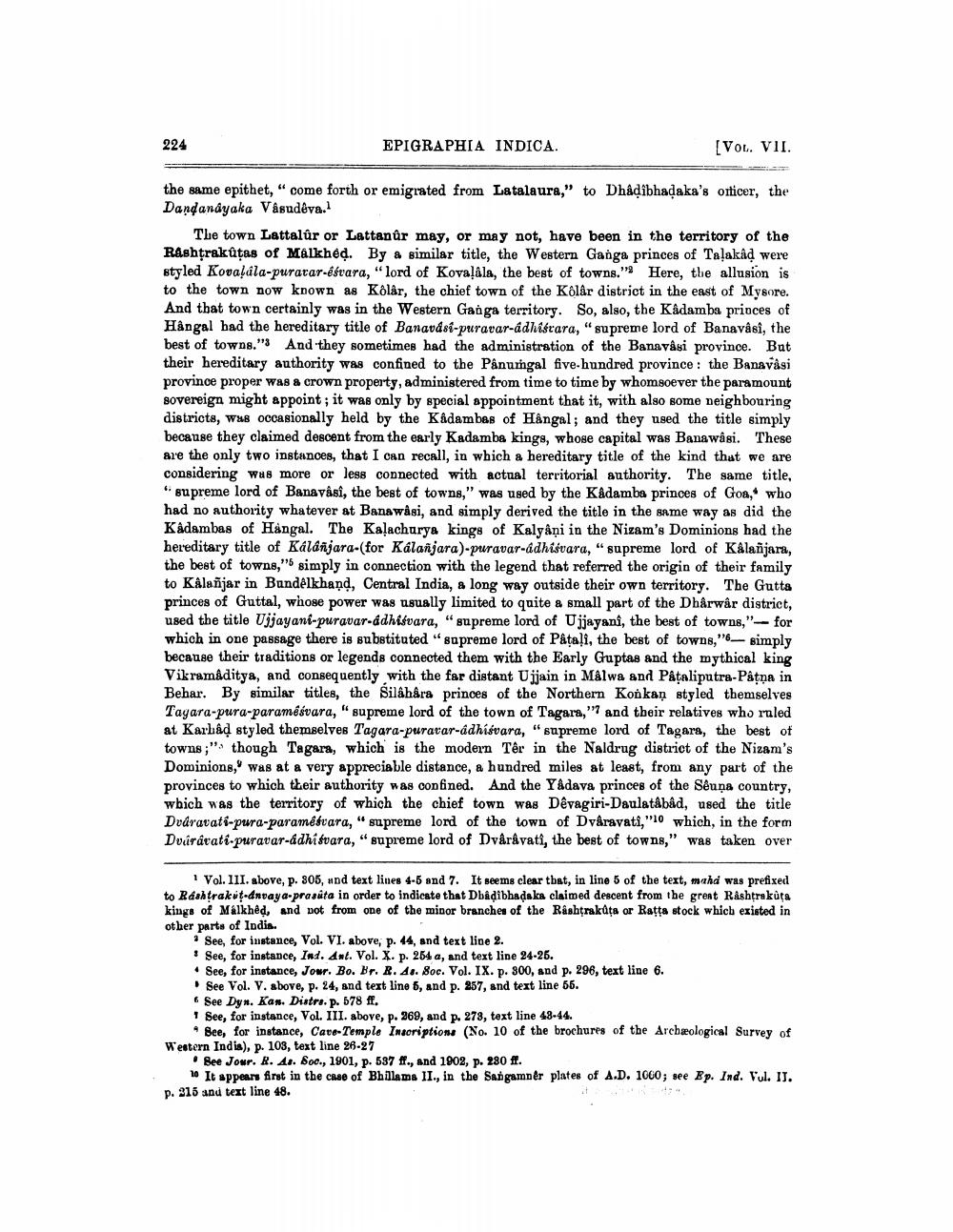________________
224
EPIGRAPHIA INDICA.
[Vol. VII.
the same epithet, "come forth or emigrated from Latalaura," to Dhadibhadaka's otticer, the Dandandyaka Vasudeva.
The town Lattalûr or Lattan úr may, or may not, have been in the territory of the Rashtrakuțas of Malkhed. By a similar title, the Western Ganga princes of Talakad were styled Kovalála-purarar-êsvara, "lord of Kovaļala, the best of towns. Here, the allusion is to the town now known as Kolår, the chief town of the Kolár district in the east of Mysore. And that town certainly was in the Western Ganga territory. So, also, the Kadamba princes of Hångal had the hereditary title of Banavdsi-puravar-adhisrara, "supreme lord of Banavâsî, the best of towns." And they sometimes had the administration of the Banavasi province. Bat their hereditary authority was confined to the Pånungal five-hundred province: the Banavasi province proper was a crown property, administered from time to time by whomsoever the paramount sovereign might appoint; it was only by special appointment that it, with also some neighbouring districts, W48 occasionally held by the Kadambas of Hångal; and they used the title simply because they claimed descent from the early Kadamba kings, whose capital was Banawasi. These are the only two instances, that I can recall, in which a hereditary title of the kind that we are considering was more or less connected with actual territorial authority. The same title, "supreme lord of Banavåsi, the best of towns," was used by the Kadamba princes of Goa, who had no authority whatever at Banawagi, and simply derived the title in the same way as did the Kadambas of Hangal. The Kalacharya kings of Kalyåņi in the Nizam's Dominions had the hereditary title of Kalanjara-(for Kalanjara)-puravar-adhisvara, "supreme lord of Kalanjara, the best of towns," simply in connection with the legend that referred the origin of their family to Kålañjar in Bundelkhand, Central India, a long way outside their own territory. The Gutta princes of Guttal, whose power was usually limited to quite a small part of the Dharwår district, used the title Ujjayanf-puravar-ddhisvara, "supreme lord of Ujjayanî, the best of towns," -- for which in one passage there is substituted "sopreme lord of Pataļi, the best of towns," simply because their traditions or legends connected them with the Early Guptas and the mythical king Vikramaditya, and consequently with the far distant Ujjain in Malwa and Påtaliputra-Patna in Behar. By similar titles, the Silâhåra princes of the Northern Konkan styled themselves Tayara-pura-parameśvara, "supreme lord of the town of Tagara," and their relatives who ruled at Karhad styled themselves Tagara-puratar-adhisvara, "supreme lord of Tagara, the best of towns;", though Tagara, which is the modern Têr in the Naldrug district of the Nizam's Dominions, was at a very appreciable distance, a hundred miles at least, from any part of the provinces to which their authority was confined. And the Yadava princes of the Sêuņa country, wbich was the territory of which the chief town was Dêvagiri-Daulatåbåd, used the title Dväravati-pura-paramétuara, " supreme lord of the town of Dvåravati, "10 which, in the form Dvararati-puravar-ddhisvara, "supreme lord of Dvåråvati, the best of towns," was taken over
1 Vol. 11I. above, p. 805, and text lines 4-5 and 7. It seems clear that, in line 5 of the text, mahd was prefixed to Rashtrakut.dnvaya-prasata in order to indicate that Dbadibhadaka claimed descent from the great Råshtrakůta kings of Málkhed, and not from one of the minor branches of the Rashtrakata or Ratta stock which existed in other parts of India.
• See, for instance, Vol. VI. above, p. 44, and text line 2.
See, for instance, Ind. ant. Vol. X. p. 264 a, and text line 24-26. • See, for instance, Jour. Bo. Br. R. 43. Soc. Vol. IX. p. 800, and p. 296, text line 6.
See Vol. V. above, p. 24, and text line 6, and p. 857, and text line 66.
See Dyn. Kan. Distrs. p. 578 ff. 1 See, for instance, Vol. III. above, p. 269, and p. 273, text line 48-44.
* See, for instance, Cave Temple Inscriptions (No. 10 of the brochures of the Archeological Survey of Western India), p. 103, text line 26-27
• See Jour. R. As. Soc., 1901, p. 537 ff., and 1902, p. 280 ff.
10 It appears first in the case of Bhillama II., in the Sangamner plates of A.D. 1000; see Ep. Ind. Vul. I. p. 315 and text line 48.




